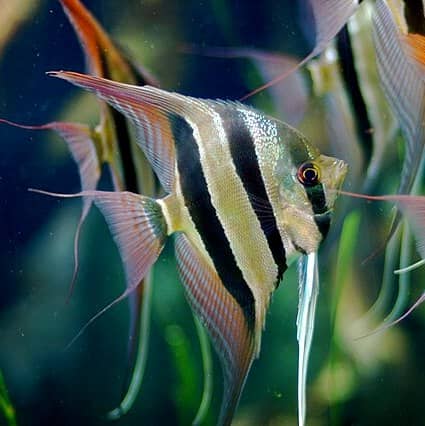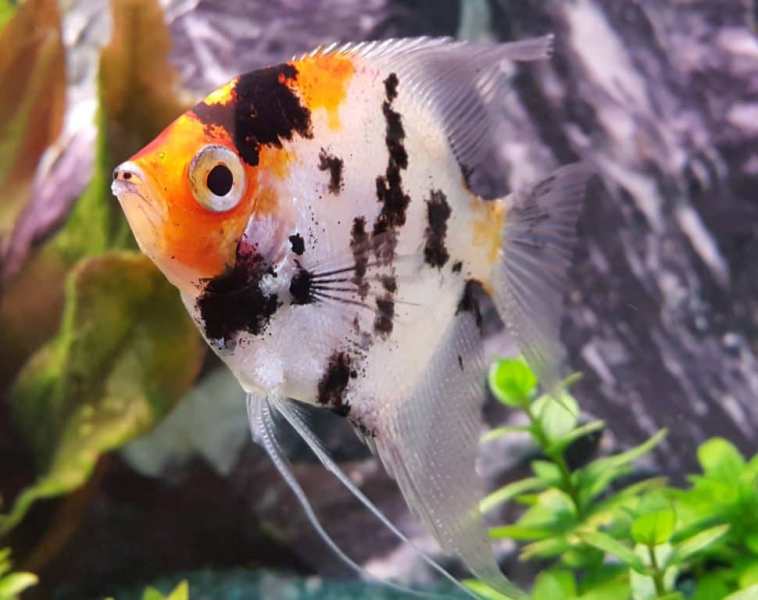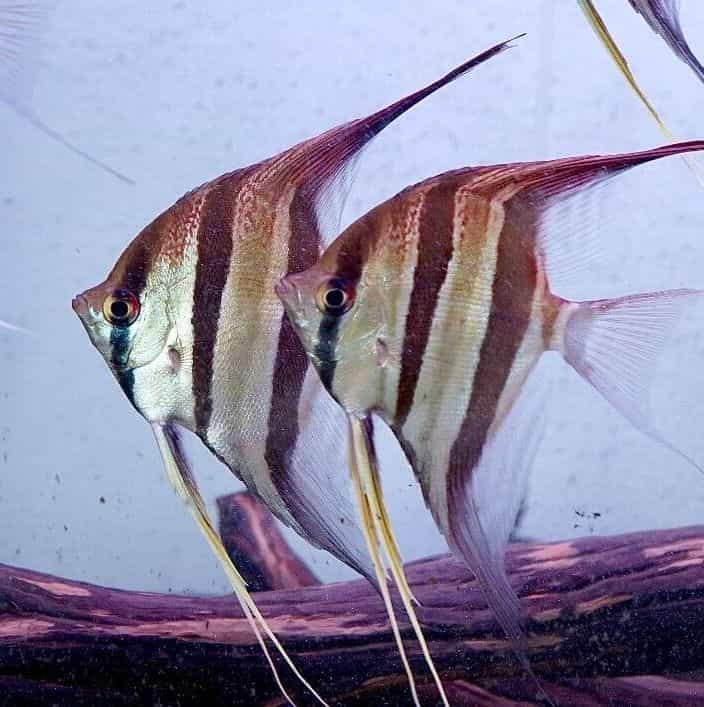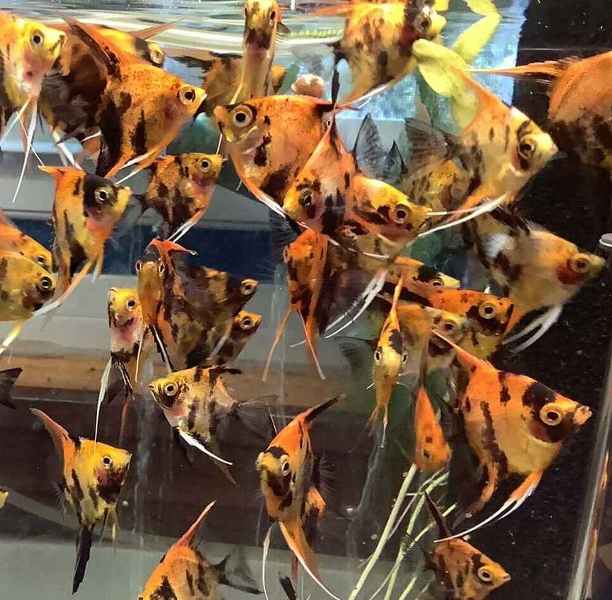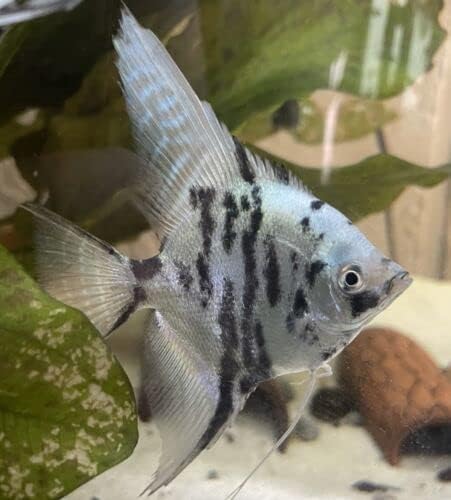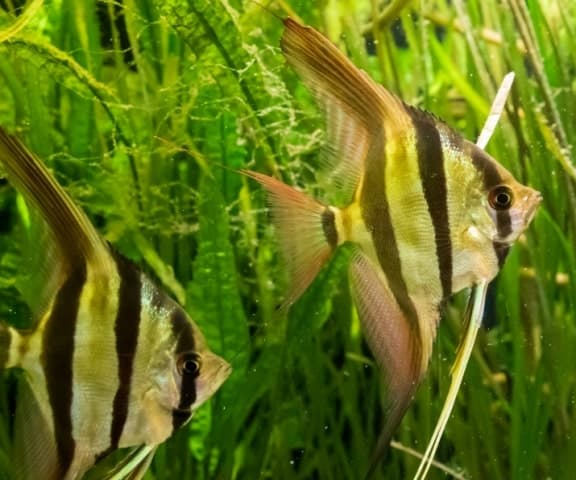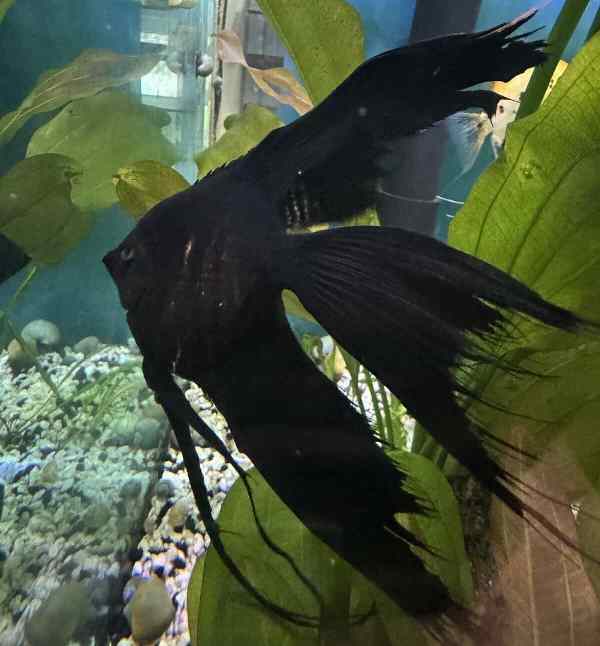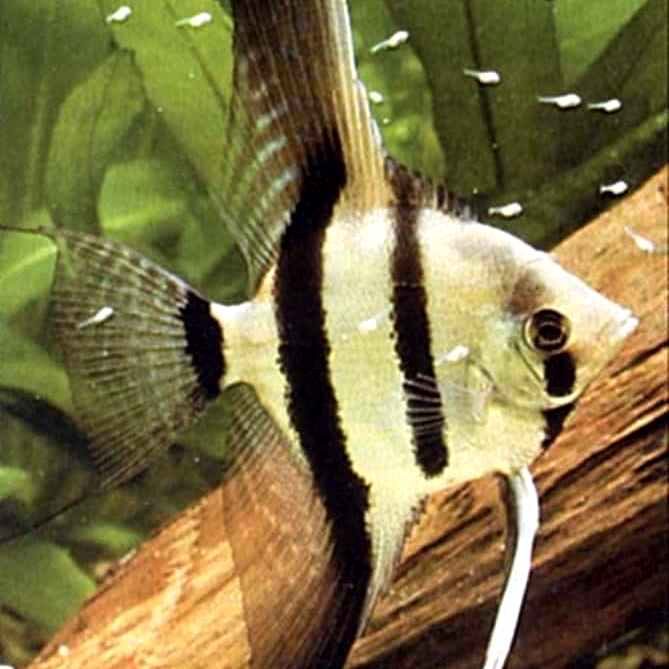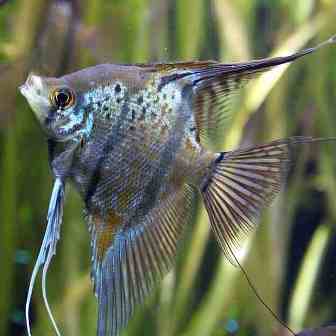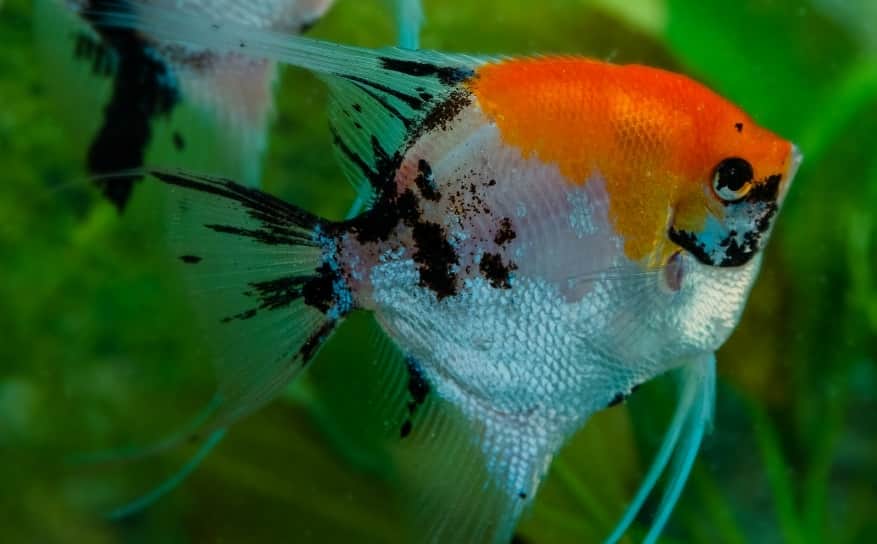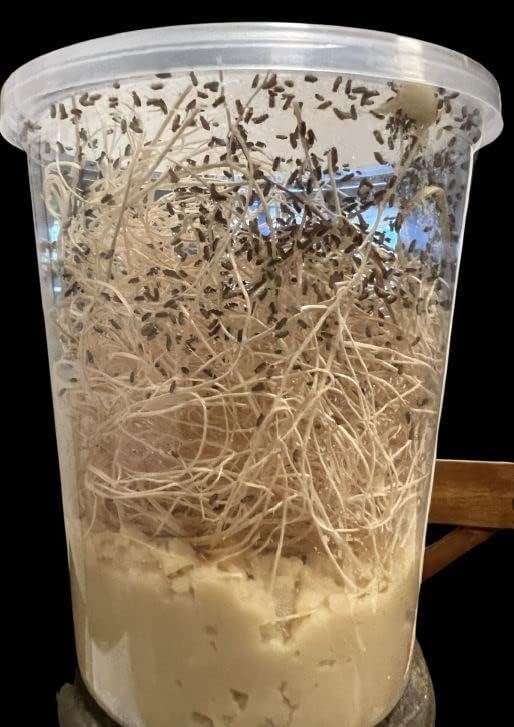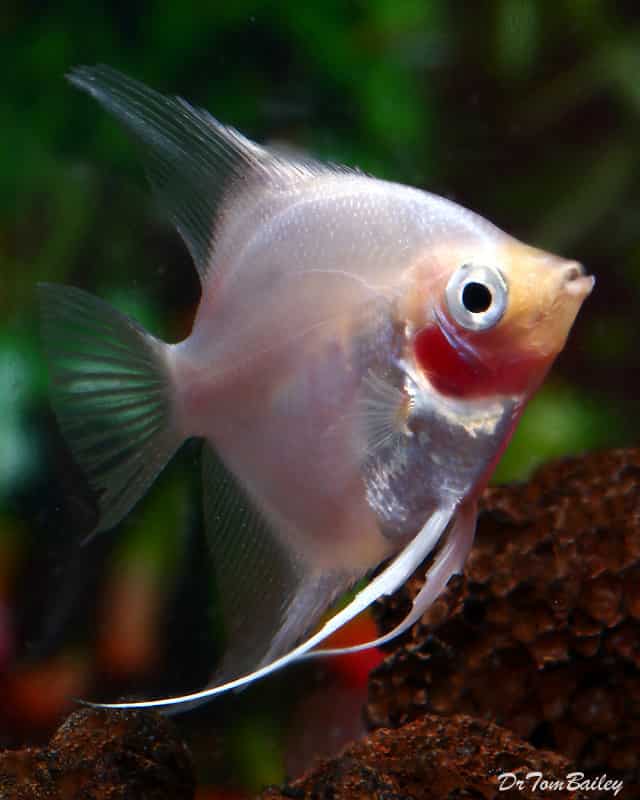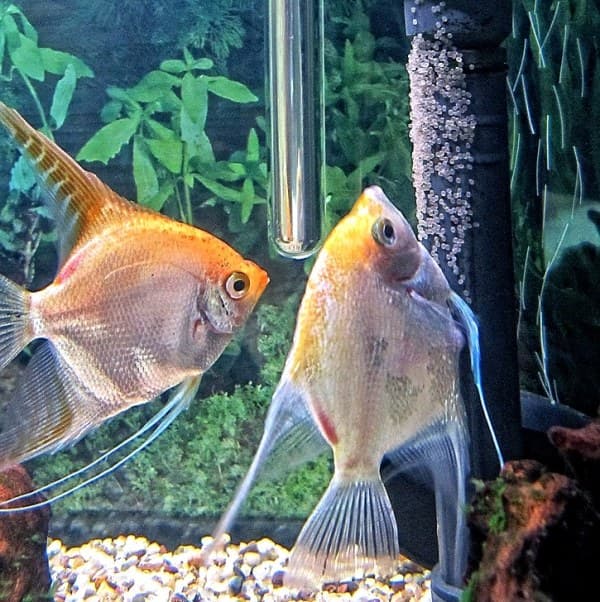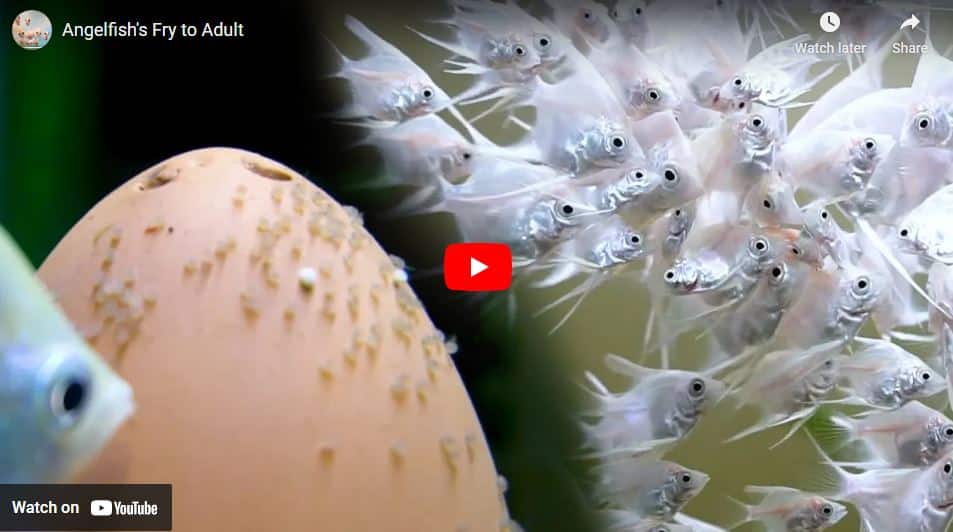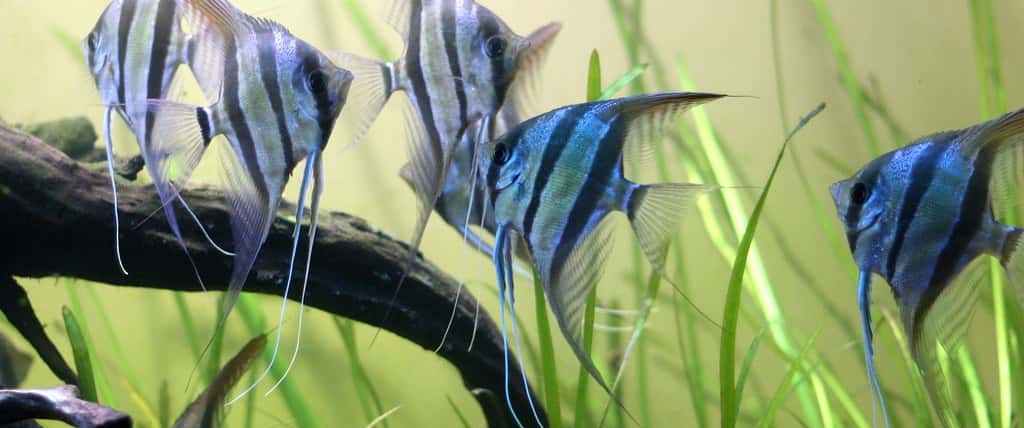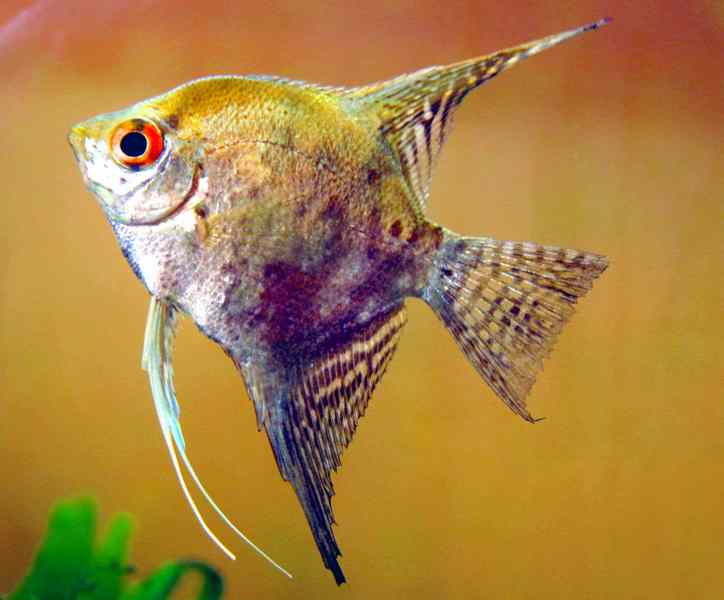Angelfish Care – Includes 31 Angelfish Pictures
You’ve come to this page because either you have just purchased a freshwater Angelfish or you are thinking about buying one.
Why are Angelfish a good choice for your community aquarium?
They are peaceful, gentle fish.
The general description of an Angelfish is that they are a medium to long finned, slim/flat-bodied fish that is 6” tall and/or wide when mature.
Well cared for angelfish will live 7 to 10 years.
Because they are personable, graceful, majestic, and come in many different colors.
Maybe color isn’t as important to you as super long flowing fins. This is an option with Angelfish.
I’ve kept Angelfish many times in the past, but not recently, because the fin nipping Tiger Barbs I keep now are incompatible with Angels.
This article will provide information about water parameters, feeding, tank mates, and diseases, plus much more.
Experience These Article in Audio Using Your Browser!
If a system or browser is not mentioned here, the I haven't been able to find out how to make the system or browser work to read aloud.
PC's: Using the Edge Browser, left click on the article text and scroll down to "Read Aloud." The article will automatically be read to you.
iPhone using the Edge Browser: Using the Edge brower, tap the icon that looks like a book with a speaker located in the in the address bar. The article will come up now showing 4 icons on top. Tap on the second icon from the right to have the article read to you.
Android phones: Google Assistant is the most convenient way. Say, "Google, read this page."
Printable Angelfish Care Guide. PDF to read or print.
Opens in a new tab or window.
Angelfish Species #1
Pterophyllum Altum
Oh Dear Lord! If you are on a desktop computer, you can see the Godzilla sized image on wikimedia by tapping the image above then tapping the image that shows up in a new window or tab.
A species of Angelfish that you can find and purchase online is the Pterophyllum Altum. I haven’t seen this species hybridized. This probably is for two reasons.
Of interest about this “wild angel” is that most Altum fish that are available in the trade are “captive bred”.
Angelfish Species #2
Pterophyllum Leopoldi
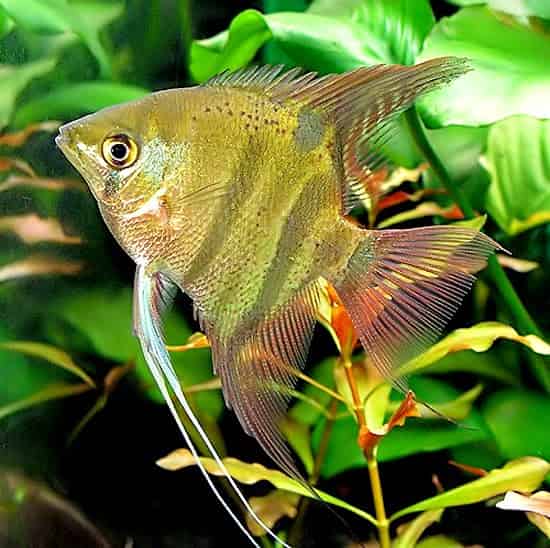
When writing this article, This angelfish species is not readily available to purchase online. I suspect the main reason for this is that they are not as attractive as the other two Angelfish species. They have a slightly more streamlined body (less tall), a golden/tan base color and a couple of light grey stripes.
All that said if you want to own some boring looking angelfish then tap here. Hate bragging rights? Buy these fish.
Thanks Wikimedia!
Angelfish Species #3
Pterophyllum Scalare
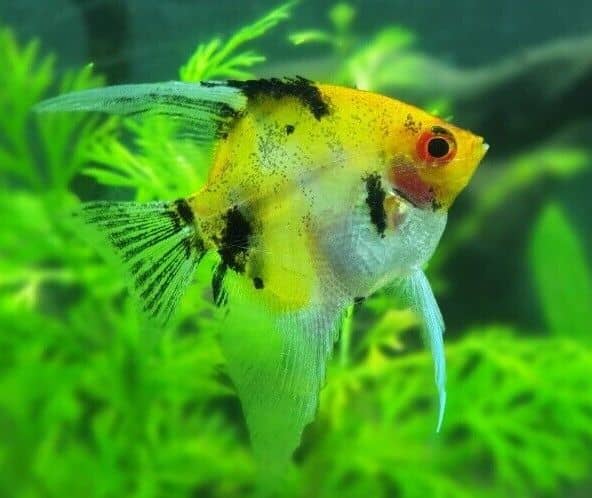
Scalare’s are why your here! All the cool pictures on this page are Scalares (except the ones to the left and directly below right, or [above and below if you’re on a cell phone] )!
The most common Angelfish species available is Pterophyllum Scalare. This is the type you’ll see in pet stores. Scalares have been heavily hybridized over the last hundred years. Their original wild colors are “silver-brown, with two or three dark grey stripes running vertically on the body. There may also be small, dark, grey spots on the top front of the body.
About the image above:
To view the high resolution (2.7 MB) image (What?? – I know, right?) of the angelfish above, tap on the picture. Image opens in a new tab or window.
You can use either image on your website, if you link back to mine:
https://plantedaquariumexpert.com/angelfish-new-concepts/
⇒ You can use the awesome images on this page on your website (just link back to my site).
Sure, you can find these pictures online if you have a few hours, but why bother. There here already. Guaranteed copyright free. Just link to this page.
Important: If there is an link under the image (usually eBay), that link must be copied and pasted near the image your borrow. We’re giving credit where credit is due.
Last thought: Do yourself a favor and view these pictures on a desktop computer.

Tap the image above to see somewhat larger picture.
Keeping fish can be costly, but there's a great way to offset those expenses.
Consider creating your own income producing website, just like I did with this one! I advertise Divi website creator, but you could place other ads on your website.
I've used Divi Wordpress website builder to build this site, and it's incredibly user-friendly. With its drag-and-drop interface, creating your own website becomes a breeze.
Simply tap this box to get started and see how easy it is to create a website with Divi.
The cost is $89/year. This is $7.41 per month. Divi comes with a 30 money-back guarantee. Try it at no risk.
Take this box to visit the Divi website to learn more. The link opens in a new window.

* Great Video: How to make a Website | Divi Tutorial 2024
Angelfish – Where do they live in the wild (originate)?
This tropical fish comes from the Amazon River Basin in South America.
As I was doing research, I noticed that Angelfish were inhabiting the slower moving river-banks and streams.
They prefer to cluster around fallen tree branches. I noticed that two different species of Angelfish were inhabiting the same dead tree. You can see this here: https://youtu.be/DPcViFxtU94?si=tVSbtc9sSj00ufKG
One of the more interesting things I learned while verifying origins is that in the wild, Angelfish may live in water with a pH down to 3 (vinegar has a pH of 2.5 to 3). To get your aquarium pH that low you’ll need to start with reverse osmosis water.
The habitat of the Angelfish provide an excellent outline of what they need/want in an aquarium.
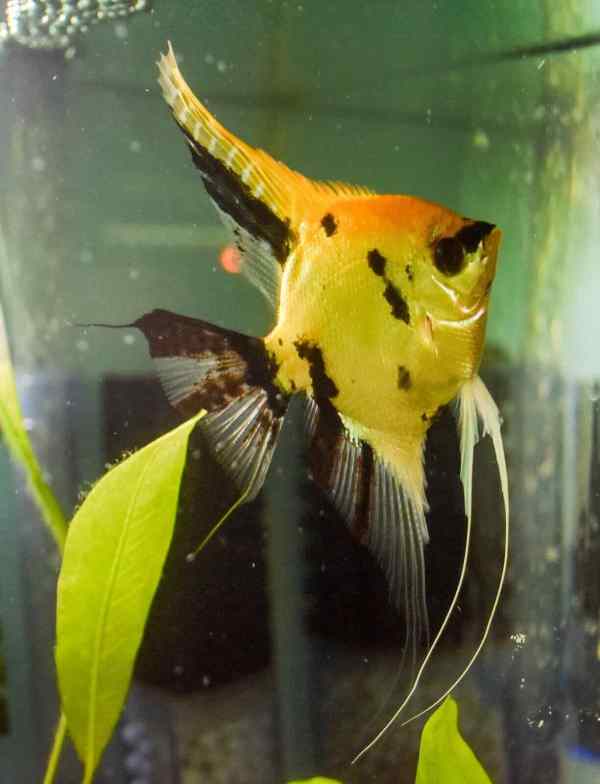
Above: Blue Angelfish
Feeling Blue? Buy a blue angelfish. You can keep each other company.
Angelfish Behavior
There are three reasons Angelfish are so popular: 1. They are physically attractive, and 2. they also “appear” to have friendly personalities, and they are easy to take care of.
I’ve kept this fish in the past and I’ll share with you what I’ve learned about their behavior.
Angelfish always beg for food. When they see their human, they swim up to the front of the tank and do short, back-and-forth swimming motions. Sometimes they are begging for fish food and sometimes they have their human trained to throw food in the aquarium when they swim like that.
For the most part, Angelfish aren’t aggressive with their tank mates. As long as the other fish can’t fit in the Angelfish’s mouths, they will leave them alone.
This changes if you have a mated pair of Angels. They don’t want other fish near their eggs and will aggressively protect the area around where they’ve laid eggs, in this case the aquarium. This can lead to the other fish stressfully cowering in the corner of the tank. Stress kills fish, so this situation is undesirable.
The best thing you can do it either move one of the pair to a different tank, or move both of the pair to a different tank in hopes of having baby angelfish. I’ll go over breeding in depth, further down the page.
Setting up an aquarium for freshwater Angelfish
Here are a few items to consider for an Angelfish aquarium setup.
Cycling The Aquarium
Most hobbyists already know what this is. In a nutshell, you set up the aquarium and have it fully running but you don’t put fish in it. You will place a bit of dried fish food in the aquarium every day, as if you were feeding fish. What you are actually doing is feeding the beneficial bacteria that break down toxic waste (in this case “uneaten food”), into the less harmful product called nitrates.
Leave the aquarium with no fish for about two weeks. By that time, the bacteria colony will be large enough to do the job that they are there for.
Add A Water Conditioner
In writing this, I am going to assume that like most water companies, yours adds chlorine or chloramine to your tap water. They do this to kill bacteria that might harm people. Unfortunately, these chemicals kill tropical fish.
We need to neutralize the chemicals to make the aquarium water safe for fish. To do this, you will want to use a water conditioner.
There are many types of aquarium water conditioners available. I’ve used API Stress Coat+ for 30 years and can highly recommend it.
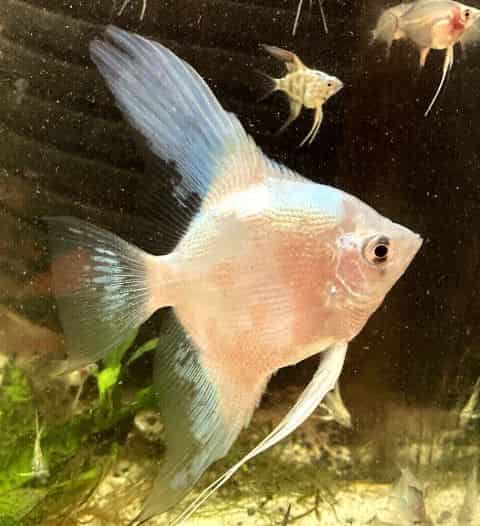
Lighting
Angelfish will not be picky when it comes to lighting. The only time lighting will probably matter is when a mated pair is spawning or caring for eggs, wigglers, or fry. If that’s the case, then lowering the light intensity is suggested. Subdued lighting will mimic what the pair would experience in their natural habitat and hopefully keep them from eating their eggs or offspring. (Looking for aquarium lights? Try this Amazon page.)
Filtration
The filtration I’ve used for years is a large canister filter with a high quality, inline UV sterilizer attached to the return hose of the canister filter. This set up filters the water and also controls harmful bacteria, pathogens, parasites, and algae.
Your filtration system will not be a cure all setup. You are also going to need to do 75 to 90% weekly, or more often, water changes. Combining the two will probably be as good as it will get for a closed aquarium.
I have used Fluval Canister filters for years. I own two currently.

Decorating Your Angelfish Aquarium
There are two different ways to go when decorating your Angelfish aquarium:
1. A natural habitat setup or
2. What most hobbyists will do.
Natural Habitat setup
If you observe angelfish in the wild, they live in very slow-moving blackwater streams. Blackwater is low in pH and high in tannins from rotting vegetation.
Usually, there are no observable plants.
There are only three things seen, besides the fish and water.
1. Tree branches – Angelfish congregate near large branches of dead trees that have fallen into the water.
2. Leaf Litter – The bottom of the streams are covered in dead, rotting leaves.
3. Biofilm – a collection of bacteria and other micro-living organisms that cover the dead tree branches the Angelfish live near. Angelfish may nibble on biofilm as a food source.
So if you want a truly natural setup for your Angelfish aquarium, do this:
1. Place leaves on the bottom of the tank. Let them rot.
2. Add driftwood.
3. Use reverse osmosis water to provide the softest, lowest pH, water that you can.
Image above: Angelfish and fry
Hobbyist setup
You can use any normal aquarium items you want to build out your aquarium. As a long time hobbyist, you might use natural colored gravel, stones, possibly driftwood and plants. Any of these items would help create an environment you would find attractive.
Personally, if I had an empty tank for Angelfish, I would create a 100% natural setting for the Angelfish I placed in my aquarium.
Water conditions and your Angelfish
Setting up the correct water conditions
1. Angelfish can adapt to your tap water as long as it’s drinkable (I.E. your water isn’t toxic).
2. As per normal for tropical fish set the water temperature at 78 degrees F. or 25 degrees C.
3. Deep Diving into water conditions: If you want to provide your angels with water similar to water in the wild, you would use reverse osmosis water (softwater) and maybe some sphagnum moss to help lower the pH.
Above: Panda angelfish
Good News! You can put a few of these beauties in your tank by tapping here.
Deep Dive: Why these water conditions for your angelfish?
If you know anything about keeping South American tropical fish, you already know that their aquarium water should be 78 degrees F. (25 degrees C.) The pH should be as low as you can get it down to perhaps a pH of 5.
The question I would ask at this point is why are these two numbers always recommended?
The answer lies in the Amazon River Basin weather patterns.
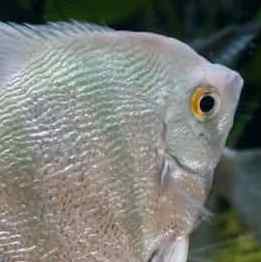
The Amazon River Basin is a tropical rain forest area on and near the equator. It covers an area of 2,400,000 square miles. The size and location allows the Amazon River Basin to create its own weather.
Water temperature in the Amazon River Basin: A process called convective uplift actually regulates the temperature of the land and water. It is a simple process in which the sun warms the ground. Because of this warming, heat and water vapor rise. As the warm air hits high cooler air, clouds form and rain falls. This is a continual cyclical process that keeps the Amazon Basin temperatures at 73 degrees F to 83 degrees F.
PH of most of the waters found flowing in the Amazon River Basin: Green plants cover every square inch of the Amazon Basin. It rains in nearly every area, every day. In fact, on average, any area in the Basin receives 91 inches of rain per year. Rain water doesn’t have many if any minerals or hardness. It has a neutral pH as it lands. (https://en.wikipedia.org/wiki/Tannin#Extraction and https://en.wikipedia.org/wiki/Humic_substance)
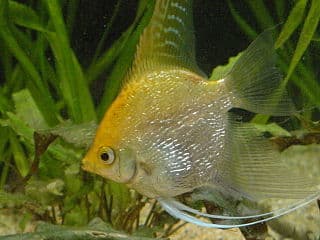
Next, as plants die, often the plant debris goes into the rivers and streams. There is so much plant debris it is rare to see any clear body of water. As it rots, this debris releases Humic Acid (notice the use of the word acid) and tannins (acidic chemicals bound in the structure of live plant material, which is released from dead & rotting plant material). This rotting vegetation and the release of chemicals, including humic acid and tannins, into the water create “blackwater” which is very low in PH. In the amazon blackwater may be light tan to brown.
Aquarists can observe the blackwater effect by adding driftwood to their aquarium. The wood will turn the water a tea color and probably lower the pH slightly.
Other plant materials sold for aquariums to lower pH are Indian Almond Leaves, Mulberry leaves and Oak Leaves. Of course, you can collect these leaves on your own near where you live.
You can learn more about the waters of the Amazon Basin here: https://php.radford.edu/~swoodwar/biomes/?page_id=2052 and here: https://en.wikipedia.org/wiki/Amazon_biome and last: https://en.wikipedia.org/wiki/Oxisol
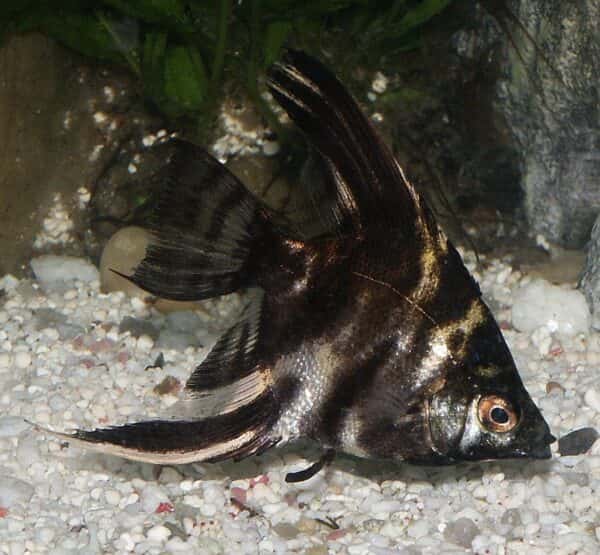
Angelfish Tank Mates
There are a large variety of community fish to place with an Angelfish.
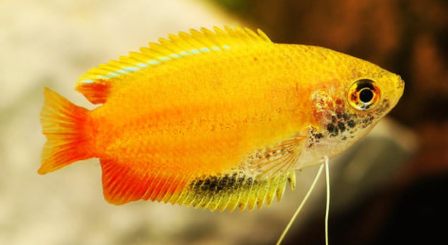
Image above: Honey Gorami
Be aware that if a tank mate can fit in the mouth of your Angelfish, that fish will be eaten.
Here are 10 suggestions for Angelfish companions:
* Slow-moving fish about the same size as an Angelfish:
1. Discus (Symphysodon Discus) – The only problem I see here is that Discus need warm water. This may not be a factor to the Angelfish. It also would be an interesting experiment to see how Angelfish do in warmer water.
2. Bristlenose (Bushynose) Pleco – They mainly keep to themselves. Keep an eye on the sides of your angelfish to make sure they are not being chewed on by the Pleco.
3. Pictus Catfish (Pimelodus Pictus) – Grows to 4.5 inches.
4. Other Angelfish (Pterophyllum scalare) – You can add more Angelfish to your tank, as long as you don’t over crowd the aquarium.
5. Molly fish (Poecilia) Up to 3 inches.
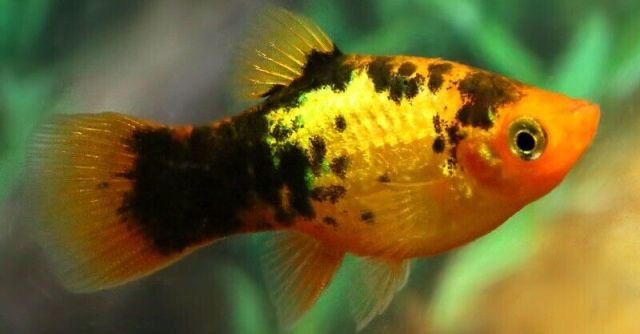
Molly fish
* Fish that stay to their own kind and won’t bother the Angelfish:
6. Zebra Danios (Danio Rerio) or just about any other species of Danio fish. These are schooling fish so keep at least a dozen at a time.
7. German Blue Rams – Mikrogeophagus ramiezi – grows to 2.5 inches
8. Keyhole Cichlids (Cleithracara Maronii) – Grows to 4 inches. Not common but available online.
9. Golden Eye Cichlid (Nannacara anomala) – Grows to 2 inches. Not common but available online.
10. Kribensis (Pelvicachromis Pulcher) – Not a South American Cichlid – up to five inches, but I’ve never seen them that big.
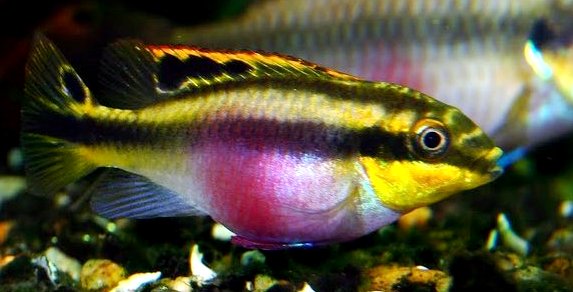
Image above: Kribensis – edited for clarity. Provided by Wikimedia.
There are many more fish types that will get along well with Angelfish. This is just a small sample.
Infograpic: Angelfish tankmates
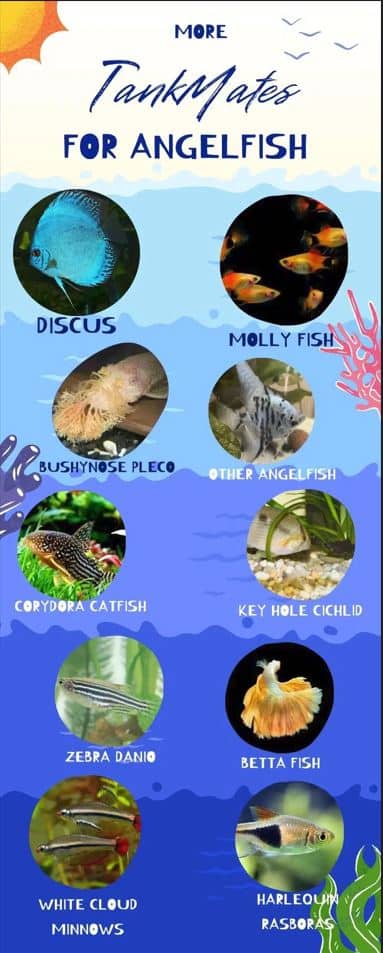
What should you feed your angelfish?
Warning: Don’t feed your fish frozen blood worms. They are too hard to digest and will kill your fish. I recently lost two good fish to that. Don’t do it.
Towards the bottom of this essay I have presented information from a scientific study with excellent information about feeding angelfish. (http://keralamarinelife.in/Journals/Vol5-12/9%20Jayalekshmi%20et%20al.pdf).
In the meantime here are some basics to feeding Angels that also apply to many other species of freshwater Tropical fish.
Above: Flightless fruit flies
Types of Foods:
I have found that processed fish food is mainly grains rather than actual fish meal. I’m not necessarily saying that’s bad, but once I discovered this I changed what and how I feed my fish.
When I changed foods I noticed that my Tiger Barbs began mating in the tank almost every day.
I try to feed foods that have the main ingredient of either fish meal or insects. This means looking at the ingredients on the container of processed fish foods and choosing food that meets my criteria.
I have also switched to mostly frozen foods. If a package of frozen foods says brine shrimp, then it’s brine shrimp and little else.
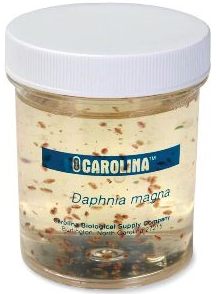
How often to feed your Angelfish:
A good rule of thumb is to feed your fish twice daily. This is what I do and my fish are happy and healthy.
How much food should you feed your angelfish?
Again, tried and true rule of thumb is as much as they can eat in 5 to 15 minutes. This kind of depends on what you’re feeding them. Live brine shrimp will be gone in seconds, cooked veggies may sit ignored for hours.
How do you breed successfully Angelfish?
How to successfully breed Angelfish by lowering their stressors

Breeding of angelfish should be fairly straightforward, but it’s not. I’ve had angelfish breed in my aquariums dozens of times. In every case, the parents ate the eggs.
That’s not a good outcome.
Here is what I would suggest if I wanted to breed Angelfish and wanted the parents to be good care takers to the fry:
- Poor food as a stressor: Feed the breeding pair good quality mostly live or live-frozen food.
- PH as a stressor: Have the correct pH: 5 to 6 is perfect. Above that, the parents are more likely to eat their eggs or the hatching fry will die more often
- Movement in or near their tank as a stressor: Give the pair their own tank and make it so they don’t see movement in the room by blacking out the sides (For example: painting the sides of the aquarium).
- Light as a stressor: Lower the lighting near the tank. In nature the lighting (sunlight) is dimmed naturally by the tannins in the water.
If you do all five steps above you will have a successful Angelfish breeding with healthy fry as the outcome.
Angelfish diseases / illnesses – prevention and cures
Here is an excellent site for information on these diseases and other fish diseases: https://www.academia.edu/699360/A_ZFishDiseases
Links to Diseases:
Fish TB
Not actual TB like humans might have, but a fish infection caused by a bacteria called Mycobacterium:
Symptoms:
Tissue erosion around the mouth is common.
Fish may experience a loss of appetite, sluggishness, protruding eyes, skeletal deformity, fin rot and body swelling. Not all symptoms are listed here. It seems possible (likely?) that some illnesses are misdiagnosed and are actually Fish TB.
This disease can also infect humans.
It is hard to eradicate and extremely common in aquarium fish.
Just bought a fish from your pet shop? Congratuations, your aquarium now has Fish TB floating around in it.
Fish TB Treatment:
No known cure. Diana Walstad added UV sterilization to her tank. That seemed to fix the issue.
Diana Walstad:
https://dianawalstad.files.wordpress.com/2017/05/mb__2017c.pdf
My suggestions to control fish TB:
An ounce of prevention is worth a pound of cure. Add a quality UV light, over-filter the tank and do frequent massive water changes. This will (probably) eliminate the Fish TB you brought home.
Dropsy
Symptoms – Rarely curable. Most fish with dropsy will die. Body swelling and protruding scales.
Treatment – Move to a quarantine tank. Set temp at 80 degrees. Use Kanamycin or tetracycline.
Reference – https://www.academia.edu/699360/A_ZFishDiseases
Fin Rot
Symptoms – Fins rotting, blood seen at the edges of the rotting fins. White cotton like growths seen.
Treatment – Move to a quarantine tank. Use Kanamycin or tetracycline.
Reference – https://www.academia.edu/699360/A_ZFishDiseases
Pop Eye Disease
Symptoms – Eyes swell up and seem to “pop” out of the eye sockets.
Treatment – Usually caused by poor water conditions.
My advice: Change 100 percent of the tank water daily for a week, then keep the tank very clean. Then change 90% of the tank water weekly thereafter.
Reference – https://www.academia.edu/699360/A_ZFishDiseases
Fungus
Symptoms – Cotton-like growths on the body of the fish.
Treatment – Treat all the fish in the tank. Raise temperature to 80 degrees F. Add salt if possible. Use a fish fungicide.
Reference – https://www.academia.edu/699360/A_ZFishDiseases
Gill Disease
Symptoms – Swollen gills, gills covered in mucus, fish gasping at the surface of the water.
Treatment – Change 100 percent of the tank water daily for a week. Then to prevent reinfection change 90% of the water weekly.
Or you can use the information that this gentleman suggests:
Reference:
Hole-In-Head Disease
Symptoms – Often caused by protozoa. Started by poor aquarium conditions.
Treatment – Change 100 percent or more of the tank water daily for a week. Then to prevent reinfection, change 90% of the water weekly.
Add a high quality UV sterilizer to your aquarium.
Or you can use this advice:
Reference – https://www.academia.edu/699360/A_ZFishDiseases
Ich
Symptoms – White spots on the fish’s body. Usually caused by poor tank maintenance and/or fish stress.
Treatment – Change 100 percent or more of the tank water daily for a week. Then to prevent reinfection clean the tank weekly by changing 90% of the water.
Add a high quality UV sterilizer to your aquarium.
Reference – https://www.academia.edu/699360/A_ZFishDiseases
Aquarium Mastery for Experts and Beginners
This is what I do and it really works.
I (the author of the article) spent a year experimenting on how to keep freshwater aquarium fish healthy and alive. I’ve learned a lot and have had excellent results. Do the following and your fish won’t become ill. You’ll say “overkill” but I know what has worked.
1. Weekly 90% water changes. My (community well) water doesn’t have nitrates in it. I heavily treat the water with API Stess Coat +.
2. I added a sump. It was a pain to start/set up but now I wouldn’t have an aquarium without one. One advantage: my sump setup super-oxygenates the water.
3. Get rid of most or all of the gravel. I know now that parasites and pathogen live in and grow in gravel.
4. I have two large Fluval cannister filters on my 30 gallon aquarium which are constantly running. I super clean the water.
5. I have two expensive UV sterilizers hooked up to the output of the cannister filters. UV sterilizers are supidly expensive ($200 each as of this writing mainly because there is only one company that makes high-quality UV sterilizers). UV sterilizers are also fickle meaning the bulbs burn out much faster than the UV company says. They are supposed to last a year but I’m lucky to get five months out of them. Replacement cost for a bulb is $50.
6. I feed my fish 2 times a day. I want fat bellies on all the fish.
Doing these six items has allowed me to overstock my tank with 14 zebra danios, 5 tiger barbs, a female betta, a bristle nose pleco and some guppies. Everyone is fat, happy and healthy.

Master The Art of Feeding Angelfish Fry
A scientific Study
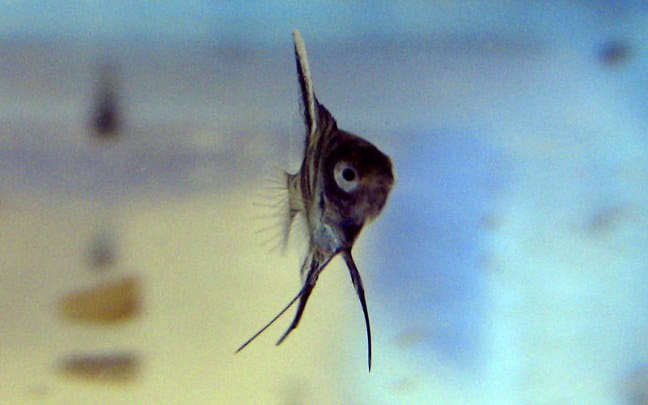
http://keralamarinelife.in/Journals/Vol5-12/9%20Jayalekshmi%20et%20al.pdf
** Take away from this study:
A scientific study at the University of Kerala (India) found young angelfish grow best when they were fed a diet of live tubifex worms. I suspect that dried tubifex worms would work also.
The study used a formulated control food (rice flour, groundnut oil cake, tapioca powder and rice bran), live bloodworms, live tubifex worms and live, common red worms.
The angelfish in this study were 10 to 15 days old. They were fed 5% of the total body weight of the total fish weight in the tank, twice daily. They could eat as much as they could in two hours, and then the leftover food was removed.
The tables below are provided courtesy of Jayalekshmi, J.N., Kurian Mathew Abraham and
Sobhanakumar, K. and Department of Aquatic Biology & Fisheries, University of Kerala
The compostion of the foods fed to the angelfish in this study are as follows:
Control Food
Crude Protein: 36.00%
Fat: 4.41%
Ash: 3.10%
Crude Fiber: 3.00%
Moisture: 56.36%
Tubifex Worms
Crude Protein: 42.80%
Fat: 5.11%
Ash: 7.79%
Crude Fiber: 3.04%
Moisture: 41.55%
Blood Worms
Crude Protein: 41.80%
Fat: 9.72%
Ash: 12.34%
Crude Fiber: 2.90%
Moisture: 34.00%
(Cultured) Red Worms
Crude Protein: 42.20%
Fat: 7.71%
Ash: 10.23%
Crude Fiber: 2.56%
Moisture: 38.18%
For comparision only: TetraMin Tropical Flakes
Crude Protein: 46.00%
Fat: 11.00%
Ash: Not given
Crude Fiber: 3.00%
Moisture: 6.00%
Food type fed vs weight gain:
Control Food
Angelfish weight at start:
0.85 grams
Day 30 Angelfish weight:
1.05 grams
Day 60 Angelfish weight:
1.34 grams
Day 90 Angelfish weight:
1.83 grams
Angelfish total weight gain:
.98 grams
Angelfish % increase in weight:
115%
Tubifex Worms
Angelfish weight at start:
0.99 grams
Day 30 Angelfish weight:
1.27 grams
Day 60 Angelfish weight:
1.75 grams
Day 90 Angelfish weight:
2.46 grams
Angelfish total weight gain:
1.47 grams
Angelfish % increase in weight:
148%
Blood Worms
Angelfish weight at start:
0.94 grams
Day 30 Angelfish weight:
1.01 grams
Day 60 Angelfish weight:
1.11 grams
Day 90 Angelfish weight
1.42 grams
Angelfish total weight gain:
.48 grams
Angelfish % increase in weight:
51%
(Cultured) Red Worms
Angelfish weight at start:
0.78 grams (day 0)
Day 30 Angelfish weight:
1.06 grams
Day 60 Angelfish weight:
1.37 grams
Day 90 Angelfish weight:
1.79 grams
Angelfish total weight gain:
1.01 grams
Angelfish % increase in weight gain: 129%
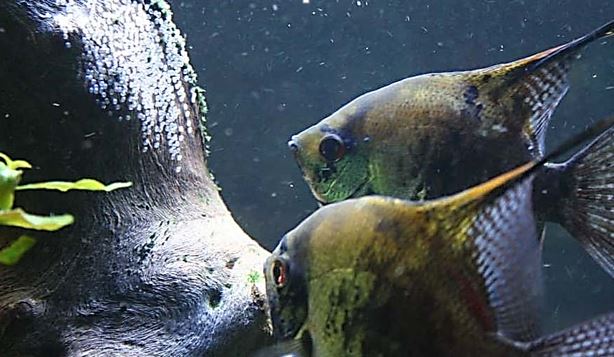
Take away number 2: As far as feeding angelfish fry and angelfish, what can be deduced from this study?
* In looking at the differences in food composition, what jumps out at me is that the tubifex worms have about half the fat as the blood worms. The ash amount of the tubifex was 37% less than the blood worms. Also the moisture was 18% higher in the tubifex worms vs the blood worms.
* Obviously live tubifex worms are a great food for angelfish. The worst food in this study was the bloodworms. The scientist who did this research suggested that blood worms are difficult to digest.
* We can use this study as a guide to deciding what food to feed angelfish for maximum growth. Fish foods that are low in fats and high in moisture might be the best foods. In looking at the fish foods I have in my home, TetraMin flake food doesn’t fit this ideal. API tropical flake food comes closer with 5% fat (min).
* My conclusion is feed your angelfish live foods, or frozen live foods, but not bloodworms. Look at the package for fat content (it should be around 5%) and moisture content above 40%.
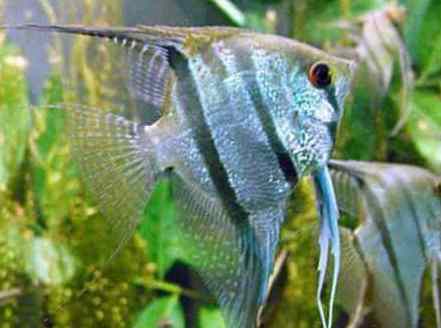
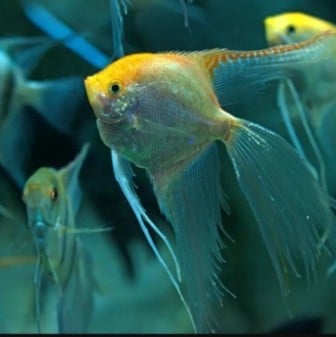
Insights from an Enthusiast:
Seven Lessons I’ve Learned About Successful Angelfish Keeping, Feeding, and Breeding!
1. Live tubifex worms:
Live tubifex worms may be the best food for young angelfish. They might be the best food for adult angelfish, also. A scientific study showed a 41% higher growth rate in young angelfish after 90 days on tubifex worms, than the next best food and the control food. One other common live food did very poorly in the study.
2. Baby brine shrimp:
Don’t feed brine shrimp naupili to newly hatched angelfish. The nauplii are often too large for the young angelfish to fit in their mouths or swallow. There are much better food sources available.
3. Water PH 6.8 or much less:
Angelfish eggs and newly hatched angelfish are much more likely to survive and thrive in a water pH of 6.8% (or preferrably lower). Common tap water pH levels, which are often much higher than a pH of 7, had mortality rates as high as 98%.
Angelfish mating pairs are less likely to eat their eggs if the water PH is 6.8 or lower.
4. Angelfish Illnesses:
Many angelfish illnesses can be cured using massive daily water changes and then kept at bay by changing 90% of the aquarium water weekly.
5. Fish TB
Nearly all aquarium fish and aquariums are infected with fish TB. UV lights might fix a major outbreak of fish TB.
6. Not skittish:
Angelfish in aquariums are not at all afraid of people.
7. Superb actors:
They constantly beg for food. The way they behave, you could swear they had never been fed.
Another article on this site: An 8 point guide to taking beautiful aquarium pictures
18. Fish, equipment and supplies mentioned in this article and where to buy:
Links To Buy All Angelfish Species:
Pterophyllum Altum
Angelfish Species
Pterophyllum leopoldi
Angelfish Species
Pterophyllum Scalare
Common Angelfish
Links To Buy All Angelfish Types and/or Variations:
Black Angelfish
Blue Angelfish
Blushing Angelfish
Marble Angelfish
Panda Angelfish
Pearl Scale or Pearlscale Angelfish
Veiltail Angelfish
Links to Food Mentioned In This Article:
Black mosquito Larvae – Not mentioned in this article but my fish love them – watch my video here: https://youtu.be/4KMy4NmAVTw
Bloodworms – not recommended for growing angelfish but mentioned
Decapsulated Brine Shrimp Naupili
Food for young angelfish – much easier than hatching brine shrimp at home.
Earthworms
Protozoa
Food for newly hatched angelfish
Rotifers
Food for newly hatched angelfish
Tubifex Worms
Links to Equipment And Supplies Mentioned In The Article:
API Stress Coat+ Water Conditioner
Aqua UV 15 watt Advantage 2000+ Hang On UV Sterilizer
Fluval 207 Performance Canister Filter
ONMOG OSC Clnr Aqua Lift Vacuum Pump
Used with a sump overflow box
CPR CS90 Overflow Box
Sump overflow box
Other pages on this site:
* Freshwater Aquarium Plants You Can Grow
* 11 Exquisite, Effortless Aquarium Plants That Totally Won't Outgrow Your Tiny Fish Tank
* Discus Fish: Because Regular Fish Just Aren't Enough of a Challenge
* Planted Nano Aquarium Magic: Tricking Your Plants Into Thinking They're Happy (CO2-Free Method)
* How to Train Your Oscars: Because Fish Totally Respond to Commands Like Dogs
* What size aquarium should you get?

